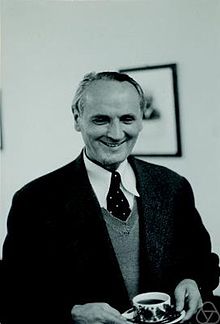Đuro Kurepa
Đuro Kurepa , Serbian: Ђуро Курепа, also Dura Korepa, Djuro Kurepa (English transcription), George Kurepa , Georg Kurepa, (born August 16, 1907 in Majske Poljane near Glina (Croatia) as Durad Kurepa ; † November 2, 1993 in Belgrade ) was a Yugoslav mathematician who studied set theory, infinite combinatorics, general topology, and number theory.
Life
Kurepa was the youngest of 14 children, was born Durad and changed his name to Duro during World War II. His nephew Svetozar Kurepa was also a well-known Yugoslav mathematician. He studied physics and mathematics at the University of Zagreb with the mathematician Vladimir Varicak (1865-1942) graduating in 1931. He then went to Paris at the Sorbonne and the College de France and received his doctorate in 1935 under Maurice Fréchet , including Arnaud Denjoy and Paul Montel were on the examination board. In 1937 he was in Warsaw with Wacław Sierpiński and he was several times in the USA (1950 Boston, Berkeley, Chicago, Los Angeles, 1959 Institute for Advanced Study , Columbia University 1959, University of Colorado in Boulder 1960). From 1938 he was assistant professor at the University of Zagreb, with a full professorship from 1946. From 1943 he headed the Mathematical Institute there. From 1965 he taught at the University of Belgrade, where he was also director of the Mathematical Institute in 1968/69. From 1968 to 1972 he was President of the Serbian Council for Education. 1970 to 1980 he was head of the Mathematics Institute of the Serbian Academy of Sciences (SANU).
He had many international contacts and mathematicians such as Paul Erdős , Alfred Tarski , Pawel Sergejewitsch Alexandrow , Thomas Jech , Nikolai Alexandrowitsch Schanin and Marc Krasner visited Belgrade at his invitation. In Princeton he met Kurt Gödel and Albert Einstein .
In work around 1935 (in the context of his dissertation) he introduced partially well-ordered sets ( called tableaux ramifiés by him ) and developed the theory of trees in set theory and introduced the names Suslin and Aronszajn trees. Early in the 1930s, he was convinced of the independence of the Suslin and continuum hypotheses from the Zermelo-Fraenkel axioms of set theory.
In 1954/55 he was a member of the CERN group with Gunnar Källén in Copenhagen (where there was also an exchange with Wolfgang Pauli ). In 1954 he was invited speaker at the International Congress of Mathematicians in Amsterdam (Le role des mathematiques et du mathematicien al'epoque actuelle) and Edinburgh in 1958 (Some principles of mathematical education).
Initially he published in French, later mainly in English (but also in German, Russian and Italian). He also spoke Spanish and classical languages.
He was married twice. First marriage to Ruzica Martinis, with whom he had a daughter, and second marriage to Nada Jagic, with whom he had four children.
He received many prizes in Yugoslavia, including the AVNOJ Prize. He was a member of the Serbian (full member since 1988) and Yugoslav Academy of Sciences (associate member since 1952) and the Academy of Sciences of Bosnia-Herzegovina (1984).
His doctoral students included Aleksandar Ivić and Stevo Todorčević .
Fonts
- Ensembles ordonnées et ramifiés, dissertation, Paris 1935, published in Pub. Math. Univ. Belgrade, Volume 4, 1935, 1-138 (in 1934 there were also articles on this in the Comptes Rendus Acad. Sci. Paris)
- Ensembles linéaires et une classe des Tableaux ramifiés (Tableaux ramifié de M. Aronszajn), pub. Math. Univ. Belgrade, Volume 6/7, 1937/39, pp. 129-160
- The theory of quantities, Zagreb: Skolska knijga 1951 (Serbian)
- Higher Algebra, Zagreb 1965, Belgrade 1969 (Serbian)
- Aleksandar Ivic (editor): Selected Papers of Duro Kurepa, Belgrade, Mathematical Institute, 1996
He was the author or co-author of 33 specialist books in Serbo-Croatian and published over 600 articles.
literature
- Zarko Mijajlovic Duro Kurepa , Serbian Academy of Sciences, Publications de l´Institut Mathématique, 57, 1995, 13-18, pdf , other articles from the booklet and list of publications
See also
- Kurepa's theorem
- Smarandache function (Smarandache Kurepa function)
Web links
- Zarko Mijajlovic Life and Work of Duro Kurepa , pdf
- John J. O'Connor, Edmund F. Robertson : Đuro Kurepa. In: MacTutor History of Mathematics archive .
| personal data | |
|---|---|
| SURNAME | Kurepa, Đuro |
| ALTERNATIVE NAMES | Kurepa, George; Kurepa, Dura; Kurepa, Djuro; Kurepa, Georg |
| BRIEF DESCRIPTION | Yugoslav mathematician |
| DATE OF BIRTH | August 16, 1907 |
| PLACE OF BIRTH | Majske Poljane |
| DATE OF DEATH | 2nd November 1993 |
| Place of death | Belgrade |
